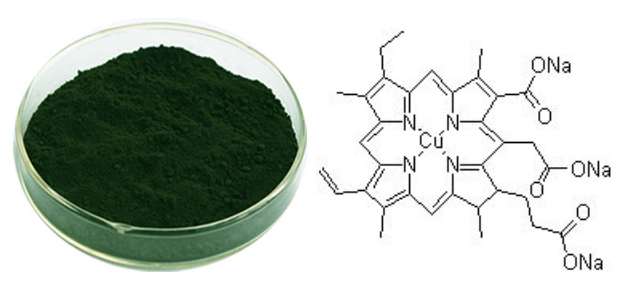Factory wholesale price for Sodium copper chlorophyllin Malaysia
Factory wholesale price for Sodium copper chlorophyllin Malaysia Detail:
[Specification] 99%
[Appearance] Dark Green powder
Plant Part Used:
[Particle size] 80Mesh
[Loss on drying] ≤5.0%
[Heavy Metal] ≤10PPM
[Storage] Store in cool & dry area, keep away from the direct light and heat.
[Shelf life] 24 Months
[Package] Packed in paper-drums and two plastic-bags inside.
[Net weight] 25kgs/drum
[What is that?]
Chlorophyll is a natural green pigment which is obtained through extraction and refining processes from natural green plants or silkworm feces.Chlorophyll is stabilized chlorophyll, which is prepared from chlorophyll by saponification and replacement of magnesium atom with copper and sodium. Chlorophyll is dark green to blue black powder, easily soluble in water but slightly soluble in alcohol and chloroform, with transparent jade green water solution without sediment.
[Function]
1.clears up odors of putrefaction effectively.
2.play an important role on cancer prevention.
3.Chlorophyll has superior coloring strength and good stabilization in neutral and alkali solutions.
4.Chlorophyll has effect on liver protection, fastening healing of stomach ulcers and intestine ulcers.
5.The active ingredient in a number of internally-taken preparations intended to reduce odors associated with incontinence, colostomies and similar procedures, as well as body odor in general.
6.Chlorophyll has strong antibacterial action, which makes it useful in surgeries, ulcerative carcinoma, acute rhinitis and rhinosinusitis, chronic ear infections, inflammations, etc.
Product detail pictures:

Related Product Guide:
To meet the customers' over-expected pleasure , now we have our potent staff to offer our greatest general service which includes internet marketing, sales, planning, output, quality controlling, packing, warehousing and logistics for Factory wholesale price for Sodium copper chlorophyllin Malaysia , The product will supply to all over the world, such as: Hungary, Wellington, Afghanistan, Now we have a excellent team supplying specialist service, prompt reply, timely delivery, excellent quality and best price to our customers. Satisfaction and good credit to every customer is our priority. We have been sincerely looking forward to cooperate with customers all over the world. We believe we can satisfy with you. We also warmly welcome customers to visit our company and purchase our solutions.
Speaker: Prof. Dr. Tomasz Ciach Warsaw University of Technology, Faculty of Chemical and Process Engineering, Biomedical Engineering Laboratory, Member of the Board of NanoVelos Sp. ,Warsaw (PL)
CLINAM 7/ 2014, 7th Conference and Exhibition,
June 23-25, 2014
https://davesmith.ludaxx.com
https://www.davegsmith.com/
https://bluelineproducts.com/
Why it Functions for over the counter appetite suppressant in this area El Paso
When it Functions for
F21 is an All Natural Sugar Blocker that assists restrict your blood sugar absorption. It consists of various substances found to have numerous wellness advantages, such as L-Arabinose, Coriolus Versicolor Polysacchride, Konjac-Mannan, Magnesium Stearate, Mint flavor: Menthol and Natural Colors. F21 not just does it help advertise weight management, (PSK) boosts your immune system feedback. In fact, for every gram of F21, you can obstruct up to 20 grams of sugar (sucrose). The formula not just assists advertise weight management, it rewards the digestion system by enabling the blocked sucrose to support helpful probiotic germs while the polysaccharide (PSK) boosts your immune system feedback.
DG Smith https://www.davegsmith.com/
over the counter appetite suppressant :
00:00:05 loose weight
00:00:11 controlling hunger
00:00:17 over the counter diet pills
00:00:23 controlling hunger
00:00:29 how to control sugar diabetes
The company account manager has a wealth of industry knowledge and experience, he could provide appropriate program according our needs and speak English fluently.







